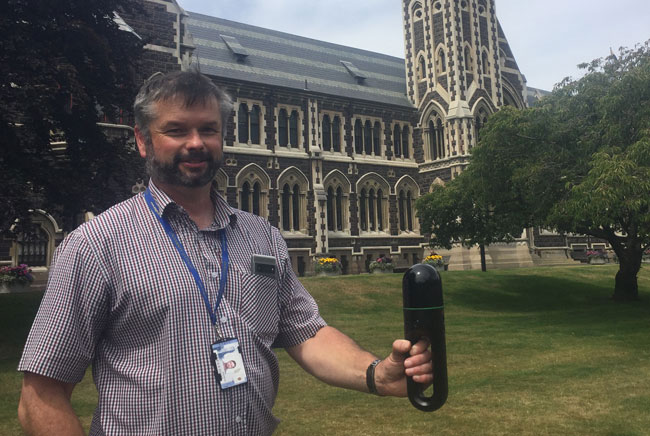Wednesday 2 March 2022 3:17pm
 A new era: Building Information and Compliance Manager Rob Wilks with the University’s new 3D scanner for buildings.
A new era: Building Information and Compliance Manager Rob Wilks with the University’s new 3D scanner for buildings.
A new laser scanner is producing virtual 3D images of University buildings to within +/- 6mm while simultaneously taking 270-degree photos, to create a treasure trove of valuable information, Building Information and Compliance Manager Rob Wilks says.
The hand-held scanner – believed to be one of Dunedin’s first – can record the exact size of each building and the spaces inside it, along with the location of assets that need maintaining or testing regularly, including heat pumps, lifts, pest traps, fire extinguishers, emergency lighting and water valves.
On the scans and photos, each asset can be geo-tagged (to pinpoint its geographical location) and relevant information added, including the type of ventilation unit in the images, its age, the size of its filters, and when those filters need to be replaced.
When loaded into University software, the information can show the location of a specific component in each identical asset, the location of those components in every building University-wide, and when maintenance needs to be done on those components.
The aim is reducing the assets’ downtime, enhancing planning and budgeting, and helping staff or contractors locate assets more easily, while enhancing health and safety in confined spaces, he says.
Revealing
A new building can be scanned and photographed for maintenance staff when it is being constructed to show the exact location of electric cables, valves, pipes, and services that will end up behind walls – which has already been trialled at the new Te Rangihīroa College being built on the corner of Albany and Forth Streets.
The scanner was also used on part of Aquinas College to understand how a new doorway would integrate with the existing driveway on the significantly sloped site because capturing the contour detail with traditional measuring methods would have been much more difficult.
A Science II building laboratory was scanned before renovation as well to accurately measure multiple services – including fume cupboard flues and heating pipes – because that is challenging to do with a tape measure or laser ruler. Using the scanner means the design of renovations is more accurate, ensuring new construction and services fit accurately into the existing environment first time.
Why?
The handheld Leica BLK2GO scanner – winner of the American Consumer Technology Association’s Best of Innovation award in 2020 – is a vital part of creating a single digital centralised asset management system, Mr Wilks says.
That system will cover all major physical assets from the ‘cradle to the grave’ – to spot unmet need, help choose the best asset for the job, plan maintenance to reduce downtime and keep the asset in top condition (reactive maintenance is usually more expensive), measure an asset’s lifecycle costs and help assess whether an item should be replaced.
Every asset management system must be based on robust information and having the $115,000 scanner radically increases the accuracy and detail of information about the University’s 800-plus buildings that cover almost 222,000 square metres. Staff can check the scanners’ measurements against existing records – a recent scan of the Hercus Building revealed the lift shaft is half a metre away from the location shown on historical plans.
Speedy
The scanner’s laser measures millions of points to produce a dimensionally accurate 3D digital model faster than staff can measure – instead of them working for several hours in the three-level 3180 gross square metre Property Services Division building in Albany Street, the new device could scan and photograph it in about 90 minutes, Mr Wilks estimates.
The scanner houses a 360° rotating LiDAR laser, three cameras, and an internal measurement unit similar to a gyroscope which lets the scanner ‘know’ its exact relative location wherever it is inside or outside a building.
Uses
Information from the scanner can also be used to enhance use of space and streamline building consent applications, building valuations, internal rent calculations, insurance estimates and depreciation assessments.
The “Google Earth-stye” panoramic photos can help staff make informed decisions about renewals as well, by showing how carpets, paint, fixtures, and fittings are wearing as areas are photographed over time.
The scanner eliminates human error, which can include Tardis-like problems when buildings are occasionally recorded as larger on the inside than outside because of measuring errors or hidden spaces such as ceiling cavities or voids being miscalculated or missed all together, Mr Wilks says.
Next
His team will be working with facility managers to create a process for scanning and photographing our buildings and the assets inside them.
All his team uses the system: Design and Building Information Manager Warren Smith, Building Services Draughtsperson Mike Brecht, and Architectural Technician Brad Humphries.
The team identified the new system with help from Lennon Bedford at Global Survey and Richard Hemi at the School of Surveying and is looking forward to further collaboration with the school.
Property Services Division Director Dean Macaulay says: “This acquisition of the Leica BLK2GO scanner is an integral part of Property Services’ maturity journey. With a large portfolio of deferred maintenance and a limited budget to address that in the short term, applications such as this provide improved data for better decision making and planning in the short, medium and long term.”
BLK2GO Facts
Weight: 775 grams
Battery Life: 45 minutes
Scanning range: 25 meters
Storage Capacity: 500Gb (Six Hours)
Height: 279mm
Diameter: 80mm
Manufacturer: Leica
The Property Services Division is part of our Operations Group, which has three top priorities:
Enable – the University to achieve its visions and mission
Engage – with our students, each other, our customers and externally
Experience – of our students, our customers, and externally to be outstanding
